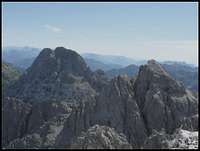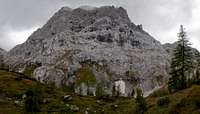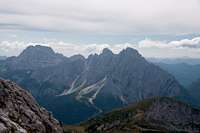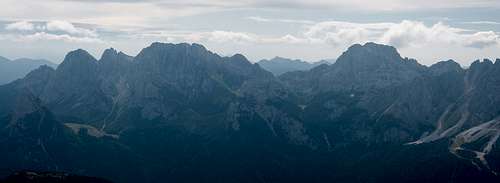-
 9875 Hits
9875 Hits
-
 81.18% Score
81.18% Score
-
 13 Votes
13 Votes
|
|
Mountain/Rock |
|---|---|
|
|
46.54245°N / 12.73607°E |
|
|
Hiking, Scrambling |
|
|
Summer, Fall |
|
|
8077 ft / 2462 m |
|
|
Overview
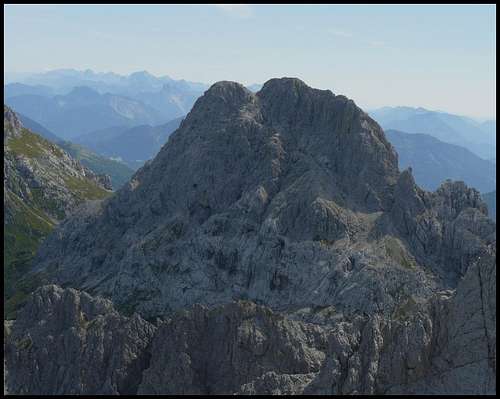 Monte Creta Forata seen from Monte Siera (by ganesh70) Monte Creta Forata seen from Monte Siera (by ganesh70) |
Migration has always played a major role in the demographics of the Alps. people came and went, most often along the important passes, which are still in use today and over the ages families, tribes and whole people left their home to settle in similar regions far away. Often economics played a major role but more often war was the reason. The best known example can be found among the Walser, a people from the Valais in Switzerland, who migrated as far as the Allgäu Alps when their pastures wouldn't feed them anymore. They took their culture and language with them and even today - if you look at the buildings in Kleinwalsertal near Oberstdorf you will notice the influence of the old home.
A similar migration took place several 100 km to the east, where miners from Carinthia and eastern Tirol moved south to settle in the solitary valleys of the Carnic Alps. They founded several villages, which formed German speaking exclaves in the otherwise Italian (Friulian) population. The best known of these villages are Sappada and Sauris, where until today you will be able to find German street and family names. But make no mistake: the language has morphed into a dialect which is barely understandable unless both parties make a big effort ...
Sappada is located in the upper Piave Valley, in a basin, which is surrounded by some of the most impressive ridgelines of the Carnic Alps. While the main ridge to the north is still quite popular and can be crowded on fine summer days, the Terze - Siera Group to the south is much more solitary. The mountains are harsh limestone and dolomite monoliths, most of which require a good deal of alpinistic experience to get to their top. Even the few hiking summits are not exactly easy and Monte Creta Forata is no exception.
Monte Creta Forata is the highest mountain in the eastern branch of the Terze - Siera Group, in which is occupies a central location. It is a huge twin summitted limestone mountain, which in several places displays pronounced karst phenomena. In its western ridge, a huge cave (hole) can be found, which gave rise to the name of the mountain: perforated (?) crest. The summit can be reached via a wide sloped ledge, which can be observed in the picture above, running from the bottom right to the col between the two summits. This ledge is polished in some sections while covered with scree in others. You never feel quite comfortable until you reach the col. The final ascent of the remaining 40m follows a pronounced path.
Monte Creta Forata, like its neighbours - and indeed all mountains in the vicinity of Sappada - is a wonderful lookout summit. Located right in the centre of the Carnic Alps it offers an excellent overview across this jumbled mountain range. To the east the Julian Alps can be seen while several of the eastern Dolomite mountain groups are visible in the west. Prerequisite is good and clear weather, which during our ascent was regrettably missing. No summit pano to be posted here.
Getting There
The trailhead for Monte Creta Forata is at the ski lift south of Cimasappada which leads to Rifugio Monte Siera
From Veneto
- Take motorway A27 from Venezia (Venice) to Ponte nelle Alpi
- Take SS51 (Alemagna) to Pieve di Cadore
- Take SS51bis to Lozzo di Cadore
- Take SS52 to Santo Stefano di Cadore
- Take SR355 to Cimasappada
From Südtirol / Alto Adige
- Take Brenner motorway A22 to Bressanone (Brixen)
- Take SS49 through Val Pusteria (Pustertal) until you reach Innichen (San Candido)
- Take SS52 (Carnica) to Santo Stefano di Cadore
- Take SR355 to Cimasappada
From Austria (Lienz)
- Take B100 from Lienz to the Austrian / Italian border
- Take SS49 to Innichen (San Candido)
- Take SS52 (Carnica) to Santo Stefano di Cadore
- Take SR355 to Cimasappada
Red Tape
No red tape in this area
Accommodation
Weather Conditions
Maps & Books
Maps
- Tabacco Map 001
SAPPADA-S.STEFANO-FORNI AVOLTRI
1:25000
ISBN: 978-8883150012
Maps Online
Books
- Friulanische Dolomiten & Karnische Alpen
Ingrid Pilz
Carinthia Verlag
ISBN: 978-3853785959


